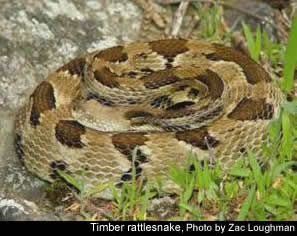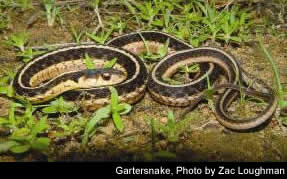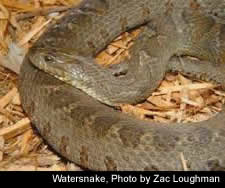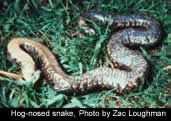

Buffet or Bare Bones: How a snake's diet is determined Story and photos by Zac Loughman Early on a June morning, a snake lies partly coiled and hidden underneath leaves. A northern copperhead starts its day by basking and waiting for a vole or mouse to pass its path. At the same time, a family walks down the same wooded trail that this snake calls home. As the humans amble closer, the copperhead becomes more aware of their presence. It rapidly flicks its tongue, trying to smell and identify the encroaching creatures. As they approach, the people become more apparent to the pit viper from the heat they are giving off. The snake is able to form a “picture” of the humans via his two facial pits allowing him to “see” body heat emitted from the warm-blooded people. As the family approaches, the copperhead braces for impact and prepares for defense. The snake lies perfectly motionless, relying on camouflage to remain undetected. The family moves down the path, passing within feet of the snake. As they move on, the snake moves to a safer place to soak up the sun. Snakes are one of the most recognized animal groups within West Virginia. The sight of their long limbless body strikes fear in the hearts of many, admiration in the hearts of few. Unfortunately for the snakes, most of their recognition comes from bad press. Separating fact from fiction about snakes can be an arduous task and is often more difficult than one would expect. If one is willing to learn, the truth about snakes is often more fascinating than fiction! Of the 22 species of snakes which call West Virginia home, 20 of them belong to the family Colubridae. Examples of colubrids are eastern garter snakes, black rat snakes, milk snakes and common water snakes. The other two snake species, the timber rattlesnake and northern copperhead, are pit vipers belonging to the family Crotalidae.
All species of snakes are carnivorous-they eat meat. Where snakes differ among each other is whether they are generalists or specialists. Generalists tend to feed on certain groups of animals -- fish, amphibians or mammals, for example. The only determining factor for these species is if the prey fits down their throat! Generalists in West Virginia that feed on rodents (such as eastern milk snakes, black ratsnakes and black kingsnakes) are beneficial members of the forest community in terms of rodent control. By feeding on mice, voles and rats, these snakes benefit agricultural areas by eliminating rodents that feed on crops and animal grain. Opposite of the generalists are specialists which feed on a very specific food source. A example of a specialist is the queen snake. This slender brown or grey watersnake, found throughout the state, only eats soft-shelled crayfish! The snake finds its prey by swimming through streams flicking its tongue and picking up the unique chemicals given off as the crayfish's shell hardens. When a crayfish is found, the snake seizes it by the tail and swallows the crustacean abdomen first. Another specialist is the eastern hognosed snake. This snake feeds exclusively on Fowlers and American toads. This is quite a task, given the highly toxic nature of these amphibians. When a toad is found buried in the sand or under an object, the hognose will seize it with its jaws and start chewing. At this point the toad has a unique defense--puffing itself up with air. But the snake's chewing action is in anticipation of the toad's behavior. Hognose snakes have two enlarged teeth, one each side of the upper jaw, which they use to “pop” toads when they puff themselves up with air. Along with deflating the toad, these teeth also allow the hognose snake's saliva to penetrate the toad's tissues. This saliva is toxic to the toad, and acts like a muscle relaxer. When the toad stops struggling the hognose will then swallow its prey and go in search of more food.
The timber rattlesnake and northern copperhead both fall within the generalist category, but it is their method of acquiring food that sets them apart from their colubrid cousins. On both sides of their faces, just below and in front of their eyes, are two cavities called pits. These specialized organs are connected directly to the part of the brain that computes vision. They are highly sensitive to differences in temperature, and literally enable pit vipers to see varying levels of heat in their environment. Because of these organs, pit vipers are able to find warm-blooded animals in complete darkness from the heat signals they give off. The other predatory adaptation that pit vipers have is their venom. This “soup” of various proteins is a hemotoxin that is injected into prey via highly modified fangs. Fangs work off the same principle as hypodermic needles, and inject venom deep into the prey's body. Once the venom is injected, the proteins in the venom break down capillary walls, causing massive internal bleeding which leads to the prey's death. This breakdown of tissues also starts the digestion process. As you can see, venom evolved in snakes for dispatching prey quickly and not for hurting people! The truth is copperheads and rattlesnakes would much rather inject their venom into a chipmunk or a mouse than you. This is why rattlesnakes have rattles in the first place, to warn potential threats of their presence! Snakes are extremely beneficial members of West Virginia's wild communities. Their important role as predators within these systems cannot be overlooked, as well as their roles as prey for several types of wildlife. Many of West Virginia's snakes are actually beautiful animals, (such as rough and smooth green snakes) and all deserve our respect. Snakes will flee if they feel threatened and only defend themselves when their lives are in danger. So the next time you find a snake along a wooded path stop a distance away and take a minute to observe the wonderful creature that lies before you. You might just realize how interesting snakes really are! Zac Loughman was a DNR research grant recipient while a Marshall University graduate student and is now a naturalist at the Schrader Environmental Education Center, Wheeling. WEST VIRGINIA'S THREATENED SNAKES West Virginia has several species of snakes that are currently undergoing declines. These snake species are on the DNR Species of Special Concern list. If you find one of these species, please contact the DNR, 304-637-0245 or Dr. Thomas Pauley at Marshall University pauley@marshall.edu. Northern Brownsnake Did You Know? •When confronted with a threat, Eastern Hog-Nosed Snakes puff up and blow air violently out their mouths, causing a loud “PUFF” noise. If this doesn't scare off a potential predator, these snakes will roll over on their backs and play dead. •Worm Snakes are West Virginia's smallest snake. They eat insects and earthworms •Eastern and Black Kingsnakes are called kingsnakes because of their habit of eating other snakes. •Milk Snakes have that name because it was once believed they would enter barns and drink cow's milk straight from the cow! This is not true. • West Virginia has only two venomous snake species, the northern copperhead and the timber rattlesnake. Cottonmouths, also known as Water Moccasins do not live within the Mountain State. •Northern Ring-Necked Snakes have saliva that is toxic to salamanders, their primary food source. This saliva is not toxic to humans. |



